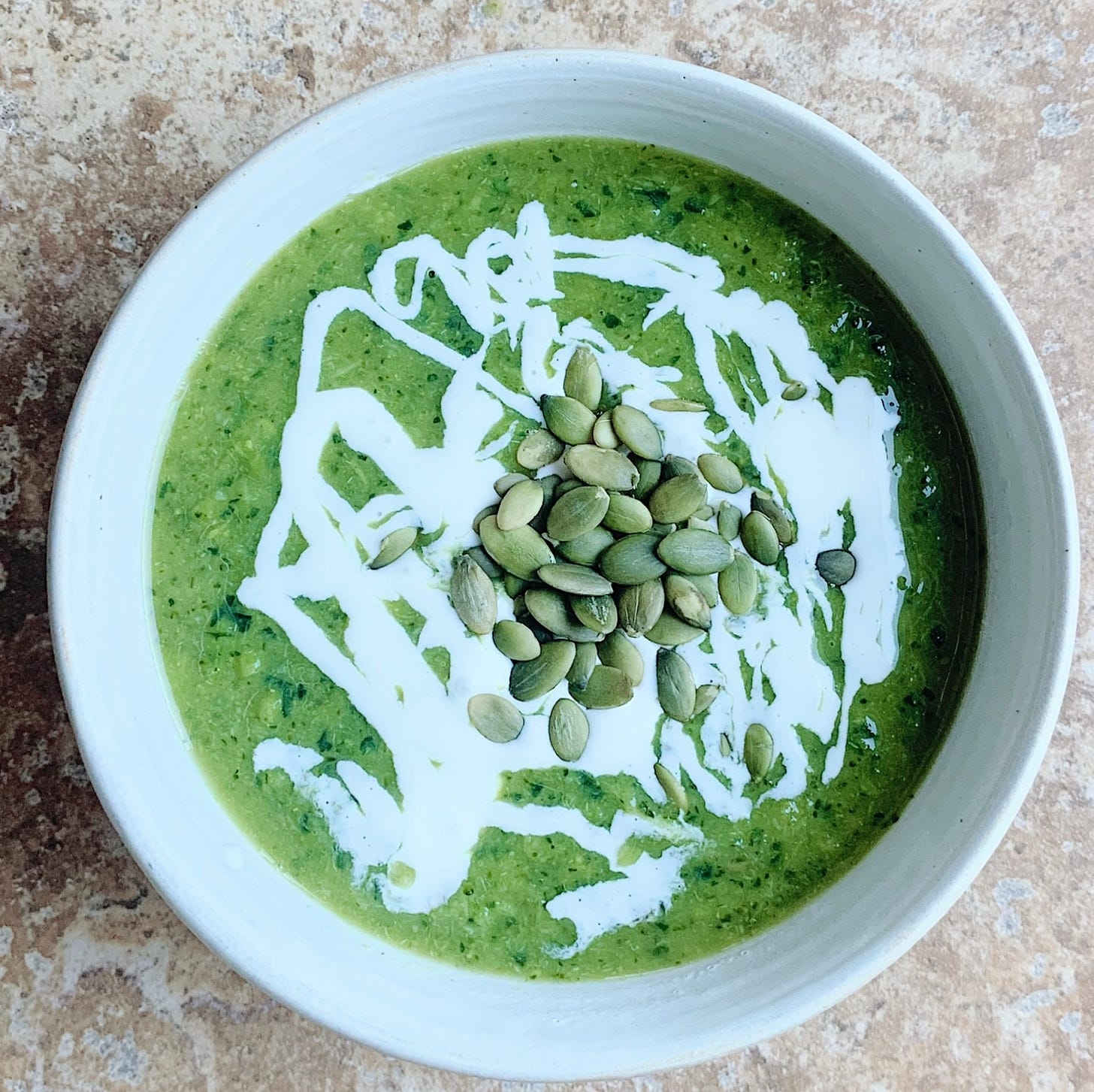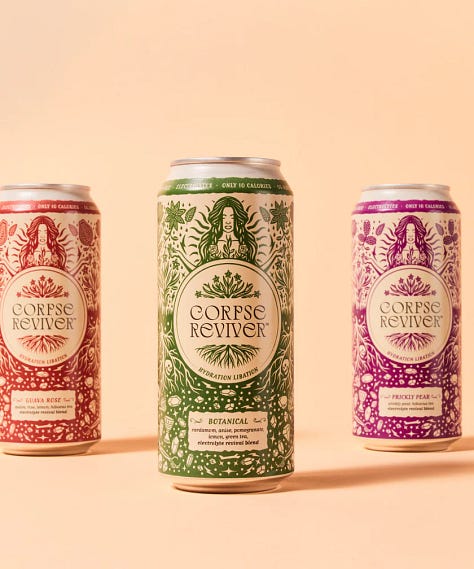Hello, everyone. I have been writing to you all summer from my outdoor office—a quiet spot on the deck where I can keep one eye on the mountains while tapping away on my laptop. Today, sadly, I am moving back inside. Partially this is because bears have been dropping by my house as they cruise the neighborhood, but mainly it’s because a nearby fire is mucking up the air. I mentioned how wildfire smoke impacts brain health a few weeks ago, not to mention it makes it hurt to breathe, so I’m doing my best to avoid smoke exposure. On the plus side, the farmers markets are at peak tomato and last weekend I brought home enough berries, peaches, and vegetables to feed us for months! I hope you are enjoying the late summer harvest in the Northern hemisphere. Down south, I bet you are looking forward to spring.
Last time we kicked off a new mini-series about brain health supplements with new information about how magnesium (Mg, for short) may protect the brain from shrinkage with age. Coming this month, we’ll also be shining our brain health spotlight on omega-3 fatty acids and curcumin (the active ingredient in turmeric), and I’ll share my updated BHK Guide to Brain Health Supplements.
If you’re new here, a BHK mini-series is when I write two or more posts that cover a brain health topic in depth. I base the topics on what you—the subscribers—are most curious to learn about. So far we have done mini-series on the health benefits of tea, cholesterol and heart disease, calcium and bone health, getting enough protein, exercising to reduce Alzheimer’s risk, the ApoE4 gene variant, metabolic health, sleep, menopause and HRT, protein powders and creatine.
Today we are digging into magnesium supplements. Did you know there are more than 10 types of magnesium you can take? Some magnesium formulas cross the blood brain barrier and play a neuroprotective role. Others stay mostly in the gut or target peripheral muscles and nerves. Wading through the hundreds of products is a daunting task!
Below, I unpack what you need to know when choosing a magnesium supplement and I’ll share my top choices for brain health. Plus, what’s the deal with the very popular magnesium drink, the sleepy girl mocktail? I even have a few special discount codes just for BHK subscribers!
The first newsletter of the month is always free. Please share!
But first, I am excited to announce that registration is now open for all subscribers for these new upcoming brain health retreats. Click “download” for all the details.
If a cozy cabana in the jungle by the beach is more your style, I’ve had a few cancellations for The Brain Health Retreat in Costa Rica.
Here’s what else is happening in September:
September 17: I’ll be at Brown University in Providence, Rhode Island to speak to the participants of the U.S. Protect Brain Health Through Lifestyle Intervention to Reduce Risk (U.S. POINTER) trial. This is a private event but I’ll be sure to fill you in on what I’m sharing.
September 19: I’ll be the keynote speaker at the Center For BrainHealth in Dallas, Texas. Join me in Dallas or stream the event here for free.
September 30: Founding Members Cooking Class & Kitchen Chat. Founding Members: I’ll be emailing you to see what you want to cook for our fall class. To join these 4x/yearly live on zoom events, free and paying subsciribers: upgrade to Founding Member.
Enrollment is now open for the latest Brain Longevity Therapy Training, an online course for health professionals, health coaches, yoga and fitness professionals, and anyone who wants to share the latest brain health science with clients. It was an honor to join the faculty of the Alzheimer’s Research and Prevention Foundation to teach the brain health nutrition modules of the course.
Should You Be Taking Magnesium?

Last time I shared a 2- minute quiz so you could gauge how much of this crucial brain health nutrient you are getting through food. If you are like half of all adults, chances are you aren’t hitting the RDA. Not only that, according to the latest studies linking low magnesium intake and dementia, the RDA for magnesium may be too low to protect the brain with age.
The RDA for adults is 320 to 420 mg of magnesium per day, but 550 mg per day may be a better dose for brain health.
Tallying how many magnesium-rich foods you eat most days is a good way to get a rough estimate of your intake. As I mentioned in my 3-pronged Mg-boosting plan, however, what really matters is how much you absorb. Certain factors (like your alcohol intake, serum vitamin D level) can impede magnesium absorption. Not only that, the magnesium content of foods may be largely overestimated because our soil no longer provides robust amounts. In general, it is best to UNDERestimate what you are getting to ensure you are getting enough.
One serving a day from each of these food groups provides a total of about 350 milligrams of magnesium, of which you absorb up to 80%: Nuts, seeds, beans and legumes, whole grains, dark leafy greens. If you count dark chocolate as a food group, one ounce provides about 50 milligrams of magnesium.
Can you ingest too much magnesium?
Absolutely, but if you have healthy kidneys your body will easily excrete what you don’t need. If you take too much through a supplement, your body will conveniently let you know since excess magnesium leads to unwanted gastro-intestinal symptoms.
Unlike other nutrients like potassium and sodium where too little or too much can cause dangerous heart rhythm abnormalities, magnesium is very safe and forgiving. That’s one reason why physicians will liberally supplement anyone who may have a magnesium deficiency without even doing laboratory tests. Plus, serum magnesium levels are worthless (reflecting less than 3% of the body’s magnesium stores) and more accurate testing would require a spinal tap, a 24-hour urine collection test, or a special assay looking at the red blood cells.
For brain health purposes, it’s better to err on the side of getting too much magnesium than not getting enough.
Magnesium Supplements A to Z

With so many products to choose from, purchasing a magnesium supplement can be confusing. It helps to know how much you are actually getting from each product—the amount of elemental magnesium, or the percentage you absorb. It’s also helpful to define your goals with supplementation. Here, I’ve divided magnesium supplements into categories based on how they act in your body.
How much magnesium you absorb from a supplement varies. In general, supplements can provide anywhere from 30 to 150 milligrams of elemental magnesium.
Magnesium supplements for gut health
Magnesium has a mild laxative effect so it is commonly used to treat constipation. This type of magnesium is the least absorbable since it stays in the GI tract to exert its action. Your body absorbs about 20% of the amount listed on the label.
Magnesium Oxide: Useful for alleviating indigestion and constipation, but this form of magnesium is a poor choice for replenishing body stores due to its low absorption.
Magnesium Citrate: Useful for increasing bowel motility, this magnesium is somewhat more absorbable than magnesium oxide, but it’s still a poor choice for boosting brain and body levels.
Magnesium supplements for muscle, bone, or heart health
Magnesium can alleviate muscle cramps and pain, and can be part of a multi-pronged approach to prevent or treat bone loss. Some magnesium forms have been shown to support healthy blood pressure. Your body absorbs about 80% of the amount listed on the label.
Magnesium Chloride: This form has better bioavailability than oxide and citrate and can be used to support muscle and joint health while replenishing magnesium stores. Slow Mag is a popular brand; two tables provide 143 milligrams of elemental magnesium plus a dose of calcium.
Magnesium Malate: Magnesium malate is also well-absorbed and may be especially beneficial for individuals with fibromyalgia or chronic fatigue syndrome, as malate plays a role in energy production.
Magnesium Taurate: This form has high bioavailability and is thought to play a role in regulating blood sugar levels and supporting cardiovascular health by lowering blood pressure.
Magnesium Sulfate: This is the type of magnesium in Epsom salts, which can alleviate sore muscles when dissolved in bath water.
Magnesium Orotate: This type may bolster heart health by improving energy production in your heart and blood vessel tissue.
Magnesium supplements for brain health
There is a compelling argument for keeping brain levels of magnesium in the high/normal range. The evolving research suggests that a brain with a lot of magnesium on board may:
age with a more robust volume and slow down age-related cognitive decline
alleviate thinking and memory problems in older adults with mild cognitive impairment
improve sleep quality by increasing the time spent in rapid eye movement (REM) and deep sleep cycles
may reduce frequency in those suffering from migraine headaches
Magnesium Glycinate: This form combines magnesium with the amino acid glycine, making it easy on the stomach at high doses. It has a high absorption rate of about 80% that makes it an excellent choice for supplementing for brain health.
Magnesium L-Threonate: This is a newer form of magnesium designed specifically to cross the blood brain barrier and replenish stores in the brain. Magtein is a branded form of magnesium L-threonate, a combination of magnesium with L-threonic acid, a metabolite of vitamin C. This combination enhances the ability of magnesium to cross the blood brian barrier. Because of this unique delivery system, the supplement dose is high—between 1,000 and 2,000 milligrams a day—while providing about 150 milligrams of elemental magnesium to the brain. While Magtein has the potential to be the most potent way to deliver magnesium to the brain, it comes with a steep price—expect to pay $30 to $50 per month for a high quality brand.
My Top Magnesium Supplements: Here’s What I Take



When it comes to getting enough magnesium, my brain-healthy diet serves me well. I consume nuts and seeds daily in cooking or as a snack, and I also enjoy a glass of homemade cashew, almond or pumpkin seed milk each day. (It’s a great vehicle for my daily dose of creatine and my favorite protein powder!) I also eat a serving of leafy greens and dark chocolate every day, and legumes 3 to 4 times a week. And yet, I still fall short on getting the amount of element magnesium I’d like to supply to my brain each day. That’s why I choose to take two different types of brain-targeting magnesium supplements plus a Mg-rich drink. For enhanced absorption, I space taking these out throughout the day.
Relevate: Best Magnesium In a Multivitamin
Relevate is a brain health multivitamin based on brain-protective dietary patterns (the Mediterranean and MIND diets). It includes magnesium bisglycinate chelate, a form of magnesium glycinate strategically chosen to fill in the gap from dietary intake. Learn more here about why NeuroReserve chose this type of magnesium and this dosage. I reached out to NeuroReserve for a discount code for BHK subscribers and they happily obliged.
Order Relevate here and type in the discount code ANNIEMAG at checkout for $20 off. (FYI: I serve as a scientific advisor to NeuroReserve, an unpaid position.)
Momentous: Best Magnesium L-Threonate
I started taking this form of magnesium in order to optimize my sleep; while I usually get 6 to 7 hours of sleep each night, I sometimes fall short on deep and REM phases. Taking three capsules of this Momentous product (which provides 145 mg of elemental magnesium as Magtein) 30 to 60 minutes before bedtime has been a game-changer for my sleep. I tried to get away with just two capsules a day (to make it more affordable) but it wasn’t until I took all three capsules that I noticed deeper, more dreamful sleep.
Magnesium supplements may interact with prescription drugs, reducing their therapeutic effect. It’s a good idea to loop in your health care practitioner when choosing a supplement. If you have kidney disease, it is crucial to get medical clearance before taking magnesium (or any other supplement.)
What about the viral Sleepy Girl Magnesium Mocktail?
There are many iterations of this magnesium drink that’s purported to help with sleep. This non-alcoholic drink typically combines magnesium with other ingredients known for their calming and sleep-inducing properties. Here's a typical recipe: Combine magnesium, tart cherry juice, L-theanine, melatonin, and calcium in a large glass over ice. Top with sparkling water. While this drink hasn’t been proven to improve sleep quality or quantity, it makes sense that this combination of ingredients would promote better sleep. Caveat: 8 ounces of tart cherry juice, one of the few food sources of melatonin, has about 25 grams of sugar. I would avoid consuming this much sugar in liquid form as a nightly cherry juice routine could have a detrimental impact on your metabolic health.
What I drink instead of a Sleepy Girl Magnesium Mocktail: a late-afternoon Corpse Reviver. This sparkling botanical non-alcoholic drink in a can has no added sugar, delicious all-natural flavors (like botanical, prickly pear, and guava rose), and provides 175 milligrams of magnesium glycinate in each serving. I reached out to Anna Zesbaugh, the founder of Corpse Reviver, and she was happy to give BHK subscribers this special discount code. Thanks Anna!
Order Corpse Reviver here and type in BHK15 for 15% off your first order.
Now I’d love to hear from you. Do you take a magnesium supplement? If so, what type? And have you tried the Sleepy Girl Magnesium Mocktail?
That’s all for today. Next time we’ll continue our mini-series with one of the most commonly consumed supplements: fish oil (omega-3 fatty acids). Until then, I hope your month is off to a great start.
Love,
Annie
PS: I only recommend products that I have personal experience with and can highly recommend. Most of my brand partnerships are completely unpaid; a few involve affiliate links.









Hi there,
You may have covered this at somw point, but do you mind listing all the supplements you take on a daily basis?
Lynn
Thank you, Annie!!